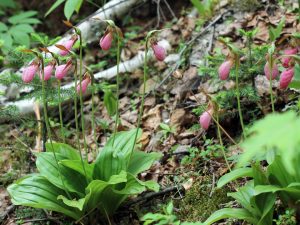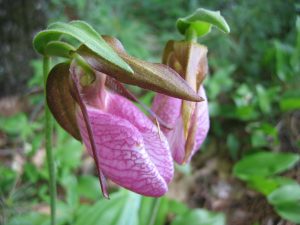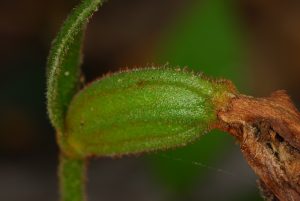Pink Lady Slipper Phenophase Definitions

Directions: As you report on phenophase status (Y, N or ?) on the datasheets, refer to the definitions on this sheet to find out what you should look for, for each phenophase in each species. To report the intensity of the phenophase, choose the best answer to the question below the phenophase, if one is included.
Leaves
Initial growth: New growth of the plant is visible after a period of no growth (winter or drought), either from above-ground buds with green tips, or new green or white shoots breaking through the soil surface. Growth is considered “initial” on each bud or shoot until the first leaf has fully unfolded. For seedlings, “initial” growth includes the presence of the one or two small, round or elongated leaves (cotyledons) before the first true leaf has unfolded.
Leaves: One or more life, fully unfolded leaves are visible on the plant. For seedlings, consider only true leaves and do not count the one or two small, round or elongated leaves (cotyledons) that are found on the stem almost immediately after the seedling germinates. Do not include fully dried or dead leaves.
Flowers

Flowers or flower buds: One or more fresh open or unopened flowers or flower buds are visible on the plant. Include flower buds or inflorescences that are swelling or expanding, but do not include those that are tightly closed and not actively growing (dormant). Also do not include wilted or dried flowers.
How many flowers and flower buds are present?
Less than 3; 3 to 10; 11 to 100; 101 to 1,000; More than 1,000.
Open flowers: One or more open, fresh flowers are visible on the plant. Flowers are considered “open” when the reproductive parts (male stamens or female pistils) are visible between or within unfolded or open flower parts (petals, floral tubes or sepals). Do not include wilted or dried flowers.
What percentage of all fresh flowers (buds plus unopened plus open) on the plant are open?
Less than 5%; 5-24%; 25%-49%; 50-74%; 75-94%; 95% or more.
Fruits

Fruits: One or more fruits are visible on the plant. For Cypripedium acaule, the fruit is a capsule that changes from green to tan or brown and splits open to expose the seeds. Do not include empty capsules that have already dropped all of their seeds.
How many fruits are present?
Less than 3; 3 to 10; 11 to 100; 101 to 1,000; More than 1,000.
Ripe fruits: One or more ripe fruits are visible on the plant. For Cypripedium acaule, a fruit is considered ripe when it has turned tan or brown and has split open to expose the seeds. Do not include empty capsules that have already dropped all of their seeds.
What percentage of all fruits (unripe plus ripe) on the plant are ripe?
Less than 5%; 5-24%; 25%-49%; 50-74%; 75-94%; 95% or more.
Recent fruit or seed drop: One or more mature fruits or seeds have dropped or been removed from the plant since your last visit. Do not include obviously immature fruits that have dropped before ripening, such as in heavy rain or wind, or empty fruits that had long ago dropped all of their seeds but remained on the plant.
How many mature fruits have dropped seeds or have completely dropped or been removed from the plant since your last visit?
Less than 3; 3 to 10; 11 to 100; 101 to 1,000; More than 1,000.
